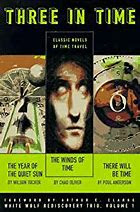John Havig, at school in the 1930s and '40s, learns that:
"A star passed near our sun and pulled out a ribbon of flaming gas that became the planets...."
-Poul Anderson, There Will Be Time (New York, 1973), I, p. 15.
This now outmoded theory of planetary formation is one of the premises of E.E. Smith's Lensman series, written in the 1930s. See:
"As Remote As Ever"
Anderson Lensmen?
Havig did not really live in such a universe because There Will Be Time is copyright 1973.
Meanwhile, his time traveling childhood continues. In 1940, two bullies who attack him complain that he has called an army to defend him. Thereafter, he is called neither Johnny nor John but Jack.
At a College party, Robert Anderson discusses Jack with the boy's mother to a background of lighted windows, buzzing conversation, a full moon, the sound of crickets, warmth, darkness and the scents of plants. Jack no longer mentions Uncle Jack but is this just because he has become even more reserved?
In 1942, Jack's father enlists and Jack becomes hysterical, saying that his father will be killed, which he is in 1943.

1 comment:
Kaor, Paul!
Hmmm, assuming the "Poul Anderson" of the Introduction to THERE WILL BE TIME was the real Poul Anderson, he might have used the outmoded theory of planetary formation to convince readers the story was NOT real. When in fact it was. Or was the use of this discredited theory a proof the story was totally a fiction?
Here you seem me becoming paranoid and coming close to offering conspiracy theories! (Smiles)
Sean
Post a Comment